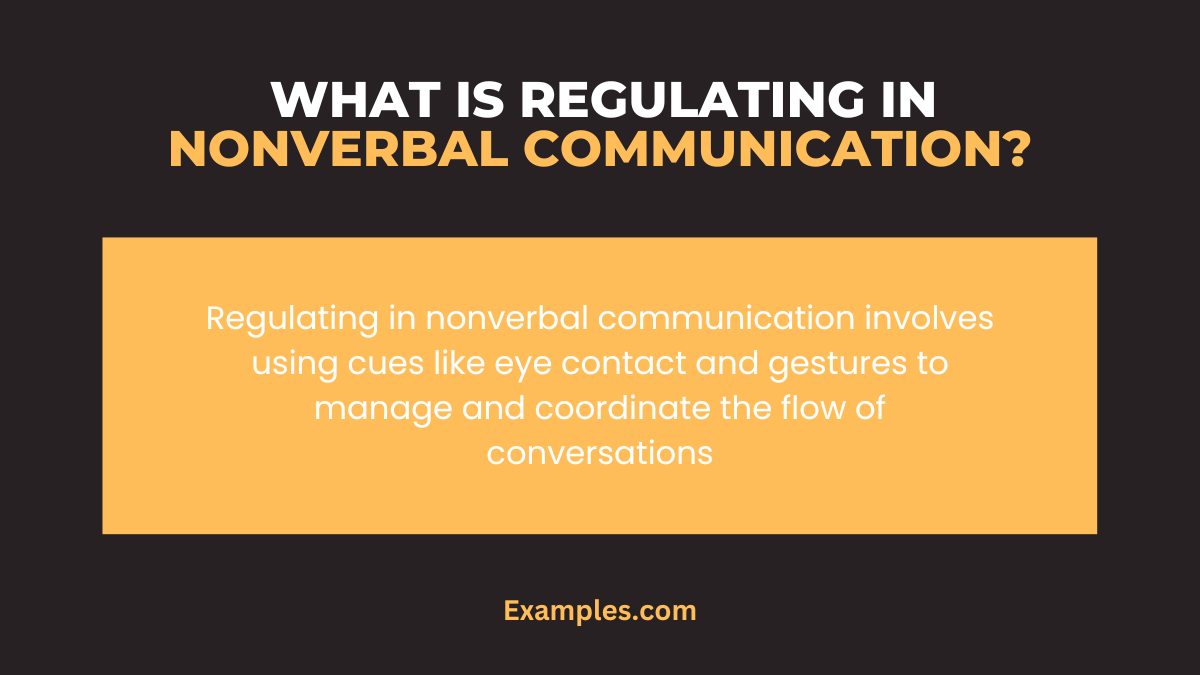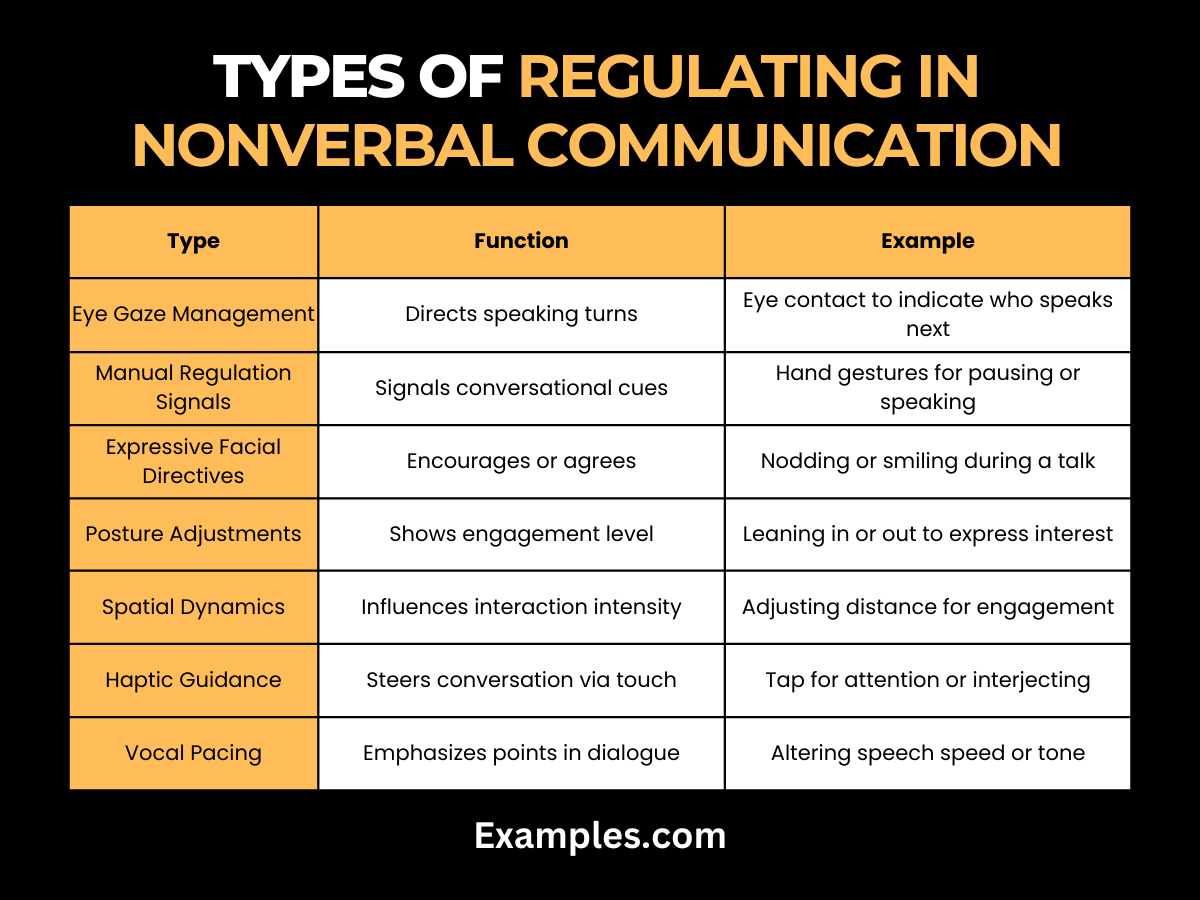Regulating in Nonverbal Communication
Regulating in nonverbal communication involves using body language, facial expressions, and other nonverbal cues to manage the flow and dynamics of interactions. This crucial aspect of communication aids in signaling when to speak, listen, or alter the conversation’s course, ensuring smooth and effective exchanges. Understanding the nuances of regulating nonverbal cues can significantly improve interpersonal communication, making it a vital skill in both personal and professional settings for maintaining engagement and harmony in conversations.
What is Regulating in Nonverbal Communication?

Regulating in nonverbal communication refers to the use of nonverbal cues to control, coordinate, or manage the flow of communication. It plays a crucial role in facilitating smooth and effective interactions by signaling when to speak, listen, or change the course of the conversation. This form of nonverbal communication includes a variety of cues like eye contact, gestures, facial expressions, and body orientation, which help in organizing the turn-taking in dialogues, indicating agreement or disagreement, and setting the pace of the conversation. Mastery of regulating nonverbal cues is essential for effective interpersonal communication, ensuring that conversations are coherent, responsive, and engaging.
Types of Regulating in Nonverbal Communication

Different methods of regulating in nonverbal communication are used to orchestrate the flow of dialogue effectively. Here’s a detailed table:
| Type | Description | Example |
|---|---|---|
| Eye Gaze Management | Utilizing eye contact to manage speaking turns. | Looking at someone to indicate their turn to talk. |
| Manual Regulation Signals | Hand signals to direct conversation rhythm. | Hand up to pause or invite others to speak. |
| Expressive Facial Directives | Facial expressions as conversational cues. | Smiling or nodding to encourage or agree. |
| Posture Adjustments for Engagement | Changing posture to reflect conversational involvement. | Leaning in to show interest, leaning back to withdraw. |
| Spatial Dynamics in Dialogue | Modifying physical closeness to influence interaction. | Closing the gap to intensify engagement. |
| Haptic Guidance in Interaction | Using touch to steer or interrupt dialogue. | A gentle tap to gain attention or interject. |
| Vocal Pacing Signals | Variations in voice tone or pace to regulate discussion. | Slowing down speech to emphasize a point. |
These types of regulating in nonverbal communication are essential in managing conversations, ensuring they are dynamic, coherent, and effectively moderated.
What are the Ways of Regulating in Nonverbal Communication?
Regulating in nonverbal communication is a key aspect of managing the flow and dynamics of conversations. Here are various ways in which nonverbal cues can be used for regulation:
Using Eye Contact Effectively
- Initiating and Ending Conversations: Eye contact can signal the start or end of a conversational turn, guiding when people speak or listen.
- Maintaining Engagement: Sustained eye contact keeps the listener engaged and indicates that the speaker is still conveying their message.
Implementing Gestural Cues
- Directing the Flow: Hand gestures, like raising a hand, can be used to signal a need to speak, interrupt, or conclude a statement.
- Emphasizing Points: Specific gestures can emphasize important parts of the conversation, guiding the listener’s attention to key areas.
Adjusting Body Posture
- Reflecting Openness or Closure: Open postures invite conversation and interaction, while closed postures can signal a desire to conclude or disengage.
- Mirroring for Rapport: Subtly mirroring the posture of the conversational partner can create a sense of rapport and encourage continued dialogue.
Managing Proximity
- Influencing Conversation Tone: The physical distance between communicators can set the tone of the conversation, from formal to intimate.
- Using Space to Convey Messages: Moving closer or farther can nonverbally express interest, comfort, or the need for space.
Vocal Nonverbal Cues
- Modulating Speech: Changes in tone, pace, and volume of speech can indicate the importance of a message or a shift in the conversation’s direction.
- Pausing for Emphasis: Strategic pauses in speech can be used to let important points sink in or to signal a change in the subject matter.
Tactile Communication
- Using Touch: Appropriate, respectful touch, like a pat on the back, can be used to affirm, comfort, or encourage in a conversation.
- Guiding Through Touch: Gentle guiding touches can be used to direct attention or subtly signal a wish to speak or change topics.
Incorporating these methods in nonverbal communication enhances the effectiveness of interactions, ensuring that conversations are coherent, respectful, and engaging. These skills are essential in both personal and professional settings for maintaining productive and positive communication.
What is the Nonverbal Role of Regulation?
The nonverbal role of regulation in nonverbal communication is a fundamental aspect of how individuals manage and control interactions without using words. It encompasses a range of behaviors and signals that dictate the flow and dynamics of communication, serving as an essential tool in social and professional contexts.
Guiding Conversational Flow
- Directing Dialogue: Nonverbal cues like nodding, eye contact, and gestures are used to indicate who should speak next, when to interrupt, or when to continue a topic.
- Maintaining Interaction Balance: These cues help in balancing the interaction, ensuring that all participants have the opportunity to contribute.
Enhancing Communication Efficiency
- Preventing Misunderstandings: By regulating the flow of conversation nonverbally, misunderstandings can be minimized, making interactions more efficient and effective.
- Clarifying Intentions: Nonverbal regulation helps in clarifying the intentions behind verbal messages, reducing ambiguities.
Facilitating Group Dynamics
- Managing Group Interactions: In group settings, nonverbal regulation is key to managing turn-taking and ensuring that the discussion remains orderly and inclusive.
- Resolving Conflicts: Effective use of regulatory nonverbal cues can also help in diffusing potential conflicts in group interactions.
Reflecting Cultural Norms
- Cultural Variations: The way nonverbal cues are used to regulate conversations can vary significantly across different cultures, reflecting diverse communication styles and norms.
- Adapting to Contexts: Understanding the cultural nuances of nonverbal regulation is crucial for effective communication in multicultural environments.
Tips for Regulating in Nonverbal Communication
Effectively regulating conversations using nonverbal communication is a skill that can greatly enhance interpersonal interactions. Here are some tips optimized for improving regulation skills in nonverbal communication:
Mastering Eye Contact
- Balanced Eye Contact: Maintain eye contact that is neither too intense nor too fleeting to manage conversational turns and engagement effectively.
- Eye Contact as a Cue: Use eye contact to signal when it’s someone else’s turn to speak or to show you are ready to listen.
Utilizing Gestures
- Clear Gestural Signals: Employ hand gestures to indicate when you wish to speak, pause, or need clarification.
- Gesture Responsively: Respond to others’ gestures to maintain a smooth flow in the conversation.
Facial Expressions as Tools
- Expressive Interaction: Use facial expressions like nodding or smiling to encourage speakers or show agreement.
- Read and Respond: Be attentive to others’ facial expressions and adjust your communication approach accordingly.
Effective Posture and Proximity
- Adaptive Posture: Adjust your posture to reflect your engagement level and to mirror the tone of the discussion.
- Proximity for Rapport: Use physical distance strategically to either create intimacy or establish formal boundaries in conversations.
Touch and Haptic Signals
- Appropriate Touch: Utilize touch, where culturally appropriate, to guide the conversation or to offer reassurance.
- Consent in Touch: Always be mindful of personal boundaries and cultural norms when using touch as a communicative tool.
Vocal Nuances
- Pacing and Pausing: Use variations in speech pace, tone, and pauses to emphasize points and to regulate the flow of the conversation.
- Tone as an Indicator: Adjust your vocal tone to align with the emotional tone of the conversation.
Observing and Adapting
- Cultural Sensitivity: Be aware of different cultural interpretations of nonverbal cues and adapt your communication style accordingly.
- Continuous Learning: Regularly observe and learn from effective communicators to enhance your nonverbal regulation skills.
In wrapping up the exploration of regulating in nonverbal communication, it’s evident that these nonverbal cues are fundamental in shaping the dynamics of any interaction. The ability to effectively use eye contact, gestures, facial expressions, and other forms of body language can significantly enhance the clarity and efficiency of communication. By mastering these nonverbal skills, individuals can navigate complex social and professional landscapes more effectively, ensuring that their intended messages are not only conveyed but also well-received and understood.
For those keen on further expanding their knowledge and skills in nonverbal communication, resources offered by the Psychology Department at Yale University provide valuable insights into the psychological underpinnings of these interactions. Additionally, The Center for Nonverbal Studies, a platform dedicated to the research and analysis of nonverbal communication, offers extensive resources that can deepen understanding and proficiency in this crucial aspect of communication.



